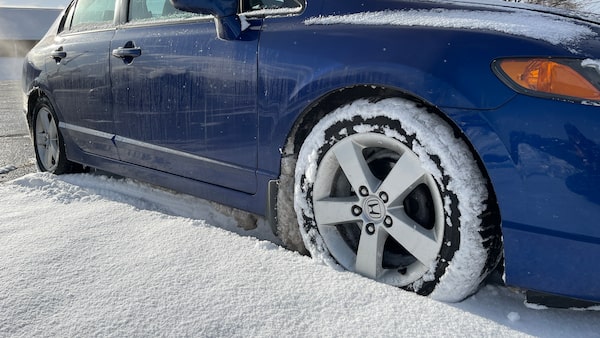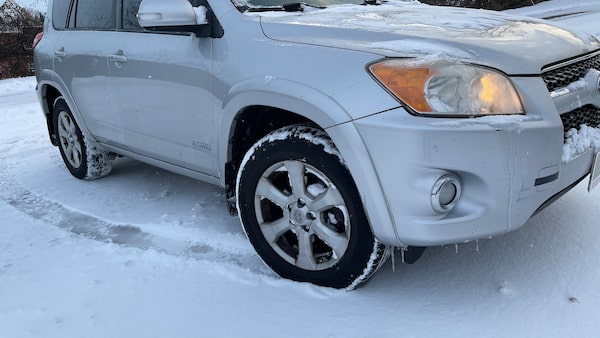
Mark Richardson's 2006 Honda Civic with Nokian WR G4 all-weather tires.Mark Richardson/The Globe and Mail
Every year at this time, drivers get pummelled by people like me telling them to fit dedicated winter tires to their vehicles – all-season tires are no match on ice and snow. When the temperature drops below 7 degrees Celsius, the rubber on those all-seasons becomes hard and inflexible, and the treads are too tight and shallow to chew through snow.
A dedicated set of winter tires means a higher initial cost (for buying two sets and preferably a second set of rims, too) and perhaps greater running costs, for swapping the tires twice a year and storing them somewhere. I save on the running costs by swapping the tires myself in the driveway and storing them in my garage, but not everyone has that luxury.
Then there’s the challenge of timing. When to do the swap? Mid-November and mid-April seem to work here in southern Ontario, but this year, I went to Los Angeles in mid-November and hadn’t yet swapped the tires on our vehicles when the first snow hit.
Related: Why do we need winter tires now, but we didn’t a few decades ago?
Related: The myth about warming up your car on a cold day
But no matter. This spring, I fitted my 2006 Honda Civic with Nokian WR G4 all-weather tires which, unlike all-seasons, apparently work well on snow and ice. Not as well as dedicated winter tires, but well enough. They can be left on all year and were comfortable and quiet in the heat of summer. So when the winter storm came through, I was keen to see whether they would prove themselves.
(Full disclosure: I won the 2021 Business Writing Award of the Automobile Journalists Association of Canada, and the tires were a prize for this, presented by sponsor KAL Tire. If I’d paid for them, installed on my 16-inch rims, they would have cost $850. You can read my award-winning story here.)
I drove from my home in Cobourg, Ont., an hour east of Toronto, to a dinner party in Mississauga, and then set out to return at 8 p.m. The bad weather didn’t hit Highway 401 until about 40 kilometres from home, but then it was bad: The dark, three-lane highway was covered in snow, visibility was poor and traffic reports on the radio kept talking of jack-knifed tractor-trailers and vehicles in ditches.
I could feel the car slipping on the road. One lane was open in the centre with two sometimes-visible tracks and nobody wanted to drive to either side. I kept my grip light on the steering wheel, but sat bolt upright, staring ahead. I wanted to drive at 80 kilometres an hour, but kept my speed a little higher because otherwise, I would have pickups and 18-wheelers pressing a quarter-second behind me, filling my mirror with their lights, or slewing past on one side or the other, leaving no room to avoid them if the traction broke loose.
Several times, I moved into the deeper snow of the right lane to let trucks pass, and the Civic seemed to slip and slide a little. Even so, I reached home without incident and treated myself to a large Scotch.
The all-weather tires were certainly no match to replace the winter tires that wore out last season, but the next day, I headed out to compare the Civic in local snow and ice to my wife’s car, a Toyota RAV4, which still had its Michelin Defender all-seasons fitted. Its Cooper Discoverer winter tires were still in the garage. On the same stretches of road, the Civic appeared to stop well shorter every time, and it turned more tightly in corners, staying in its lane.
Nokian has facts and stats to prove all of this. In snow at 60 kilometres an hour, with the temperature at minus 11, a car fitted with WR G4 all-weather tires stopped in 43 metres, compared to the 50 metres for a car fitted with Nokian Entyre 2.0 all-seasons. Another car fitted with Nokian Hakkapeliitta R3 winter tires stopped in 38 metres. You can see the test here.

Mark Richardson's Toyota RAV4 with Michelin Defender all-season tires.Mark Richardson/The Globe and Mail
On ice at 40 kilometres an hour, with the temperature at minus 10, the all-weather tires stopped in 45 metres, compared to 53 metres for the all-seasons and just 36 metres for the winters. That’s a big difference, and you can see it here.
“[All-weather tires are] a compromise,” said Steve Bourassa, Nokian Tyres’ director of products and pricing for North America, who works remotely in Burlington, Ont. “It’s not a miracle product. It’s not a unicorn. If you’ve been driving with winter tires, you’re going to see a drop in performance in extreme conditions of deep snow and really slippery ice.
“But on the flip side, the consumers that we’re trying to convince to buy this product are those who are using all-season tires year-round and have done for years. Consumers come in and say ‘I want to replace my tires and I want an aggressive all-season tire,’ and this is the product for them.”
The Nokian WR line was introduced two decades ago and is now in its fourth generation. The independent, Quebec-based Automobile Protection Association rates it as the best all-weather tire it’s tested. While all-seasons start performing poorly in single-digit temperatures, said Bourassa, the WR G4 stays fully flexible until at least minus 10, and holds up safely until about minus 25. A true winter tire should be good to about minus 40.
As well, the WR G4 has deeper and chunkier treads than an all-season, which better clear the snow from the rubber and allow more grip. The denser tread on the outside half of the tire is better for summer conditions, while the blocks of the inner half are more open, for better grip on snow and ice.
The downside is that the softer compound wears faster, but it’s not too bad: the WR G4 has a mileage guarantee of 105,000 kilometres, compared to the 130,000-kilometre warranty of its all-season equivalent.
Fortunately, my Civic spends much of its time parked while I drive other cars. Because I will leave the all-weathers on the Civic year round, I’ll be less keen now to drive it through a winter storm. That’s when I’ll use my wife’s RAV4 if I absolutely have to go somewhere – I just have to put on those winter tires first. Now, where did I leave my torque wrench?
Mechanic Lou Trottier runs through the things to look for when choosing a winter tire, and he's adamant that a set are needed for your car when the temperature starts to drop.
The Globe and Mail
Editor’s note: An earlier version of this story stated the writer would leave the all-season tires on his Honda Civic year round. In fact, he will leave the all-weather tires on year round.
 Mark Richardson
Mark Richardson